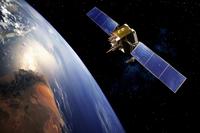-
Remote explosives detection may see the end of full-body scanners
Standing in a full-body scanner at an airport is not fun, and the process adds time and stress to a journey. It also raises privacy concerns. Researchers now report a more precise and direct method for using terahertz (THz) technology to detect explosives from greater distances. The advance could ultimately lead to detectors that survey a wider area of an airport without the need for full-body scanners.
-
-
Advancing algae’s viability as a biofuel
Lab success does not always translate to real-world success. A team of scientists, however, has invented a new technology that increases the odds of helping algae-based biofuels cross that gap and come closer to reality. The current issue of Algal Research showcases the team’s invention — the environmental photobioreactor. The ePBR system is the world’s first standard algae growing platform, one that simulates dynamic natural environments.
-
-
Countering counterfeit electronic components
Used and non-authentic counterfeit electronic components are widespread throughout the defense supply chain; over the past two years alone, more than one million suspect parts have been associated with known supply chain compromises. In the military, a malfunction of a single part could lead to system failures that can put soldier lives and missions at risk. A new DARPA program seeks tool that authenticates electronic components at any step of the supply chain.
-
-
Sandia Lab leading multidisciplinary effort to counter WMD
Threats of terrorism and weapons of mass destruction do not seem as imminent today as they did after the 9/11 attacks, but Jill Hruby, vice president of International, Homeland, and Nuclear Security at Sandia Labs, says that scientists, industry, and universities working on technological solutions to national security challenges must anticipate what could come next. Speaking at AAAS annual meeting, Hruby said that in an environment of lower public interest — due, in part, to the success of early efforts to combat terrorism that resulted in fewer major incidents in recent years — continued collaboration between national security laboratories, academia, and industry is needed.
-
-
Sensors would spot structural weaknesses in bridges, stadiums before they collapse
A team of engineers, with a grant of $1 million from the government of Qatar, will work to develop a wireless sensor network which will monitor vibrations, sagging, and stresses to assess a structure’s ability to carry its load. The proposed system would not only detect damage after it occurs, but would aim to predict it before it takes place.
-
-
New technologies make police work more effective
Law enforcement officers across the country are adapting to new technologies which aim to improve efficiency and accuracy on the job. The average police car is now equipped with a laptop which provides access to national criminal databases, portable fingerprint scanners, Breathalyzer units, automatic license-plate-readers, and even printers that can print out a citation ticket. Experts stress that while technology has equipped law enforcement officers with sophisticated resources, officers must not abandon old-fashioned practices like maintaining a personal connection with the communities they serve.
-
-
Micro-windmills to recharge cell phones, used for home energy generation
Researchers have designed a micro-windmill that generates wind energy and may become an innovative solution to cell phone batteries constantly in need of recharging, and home energy generation where large windmills are not preferred. The device is about 1.8 mm at its widest point. A single grain of rice could hold about ten of these tiny windmills. Hundreds of the windmills could be embedded in a sleeve for a cell phone.
-
-
Tracking spilled oil
A newly developed computer model holds the promise of helping scientists track and predict where oil will go after a spill, sometimes years later. Scientists developed the model as a way of tracking the movement of sand and oil found along the Gulf of Mexico since the Deepwater Horizon oil spill. The new tool can help guide clean-up efforts, and be used to aid the response to future oil spills.
-
-
Online 3D immersive learning environments to boost kids’ science skills
For the first time, a new online 3D educational world which replicates real life environments is set to improve the science skills of students. Using their avatar, students will embark on a journey from their own research lab through and “immersive learning” environments which will mirror real-life places. As they progress through quests, they will explore the surrounding environment and complete inquiry based learning tasks which test their core science skills and gain rewards.
-
-
New software obfuscation system a cryptography game changer

A team of researchers has designed a system to encrypt software so that it only allows someone to use a program as intended while preventing any deciphering of the code behind it. This is known in computer science as “software obfuscation,” and it is the first time it has been accomplished. Previously developed techniques for obfuscation presented only a “speed bump,” forcing an attacker to spend some effort, perhaps a few days, trying to reverse-engineer the software. The new system puts up an “iron wall,” making it impossible for an adversary to reverse-engineer the software without solving mathematical problems that take hundreds of years to work out on today’s computers — a game-change in the field of cryptography.
-
-
Making the U.S. grid sturdier, smarter, and more secure to thwart blackouts

In August 2003, fifty million customers throughout the northeastern United States and southeastern Canada lost power for up to two days. More than ten years later, the U.S. electric power system continues to be challenged. In the United States, 149 power outages affecting at least 50,000 customers occurred between 2000 and 2004, a number which grew to 349 between 2005 and 2009. In 2012, the prolonged power outages in New York and New Jersey caused by Hurricane Sandy once again demonstrated the system’s vulnerability. A broad, multidisciplinary effort by Georgia Tech researchers aims to revolutionize the delivery of electricity, advance the smart grid, thwart blackouts, integrate renewable energy sources, and secure utilities from cyberattacks.
-
-
Smartphones to help find avalanche victims
Not a winter goes by without an avalanche incident. In the search for those buried beneath the snow, every second counts. On average, rescuers have fifteen minutes to recover victims alive. This is why an avalanche transceiver is an essential piece of kit for anyone spending significant time off-piste. These transceivers do not come cheap, however, ranging in price from 200 and over 500 euros — perhaps one reason why many walkers and skiers still do not carry one with them. Now smartphones equipped with functions of an avalanche transceiver should help locate the victims quickly.
-
-
Quantum encryption for wiretap-proof communication a step closer

Polarized light, in which all the light waves oscillate on the same plane, forms the foundation for technology such as LCD displays in computers and TV sets, and advanced quantum encryption. There are two ways to create polarized light, but each has its problems: filtering normal unpolarized to block unwanted light waves (but here, half of the light emitted, and thereby an equal amount of energy, are lost), or using light which is polarized at the source (but here, polarization is either too weak or hard to control). Now there is a better way: By emitting photons from a quantum dot at the top of a micropyramid, researchers are creating a polarized light source with a high degree of linear polarization, on average 84 percent. As the quantum dots can also emit one photon at a time, this is promising technology for quantum encryption, a growing technology for wiretap-proof communication.
-
-
“Space cops” to help control traffic in space, prevent satellites from colliding

Collisions in space of satellites and space debris have become increasingly problematic. A team of scientists are using mini-satellites that work as “space cops” to help control traffic in space. The scientists used a series of six images over a 60-hour period taken from a ground-based satellite to prove that it is possible to refine the orbit of another satellite in low earth orbit.
-
-
Using pencil and paper to detect hazardous chemicals
Three students from Northwestern University have proven that pencils and regular office paper can be used to create functional devices that can measure strain and detect hazardous chemical vapors. The project originated during a discussion about the conductive properties of graphene, a one-atom thick layer of carbon that can be parsed from regular pencil lead.
-
More headlines
The long view
New Technology is Keeping the Skies Safe
DHS S&T Baggage, Cargo, and People Screening (BCP) Program develops state-of-the-art screening solutions to help secure airspace, communities, and borders
Factories First: Winning the Drone War Before It Starts
Wars are won by factories before they are won on the battlefield,Martin C. Feldmann writes, noting that the United States lacks the manufacturing depth for the coming drone age. Rectifying this situation “will take far more than procurement tweaks,” Feldmann writes. “It demands a national-level, wartime-scale industrial mobilization.”
How Artificial General Intelligence Could Affect the Rise and Fall of Nations
Visions for potential AGI futures: A new report from RAND aims to stimulate thinking among policymakers about possible impacts of the development of artificial general intelligence (AGI) on geopolitics and the world order.
Keeping the Lights on with Nuclear Waste: Radiochemistry Transforms Nuclear Waste into Strategic Materials
How UNLV radiochemistry is pioneering the future of energy in the Southwest by salvaging strategic materials from nuclear dumps –and making it safe.
Model Predicts Long-Term Effects of Nuclear Waste on Underground Disposal Systems
The simulations matched results from an underground lab experiment in Switzerland, suggesting modeling could be used to validate the safety of nuclear disposal sites.
